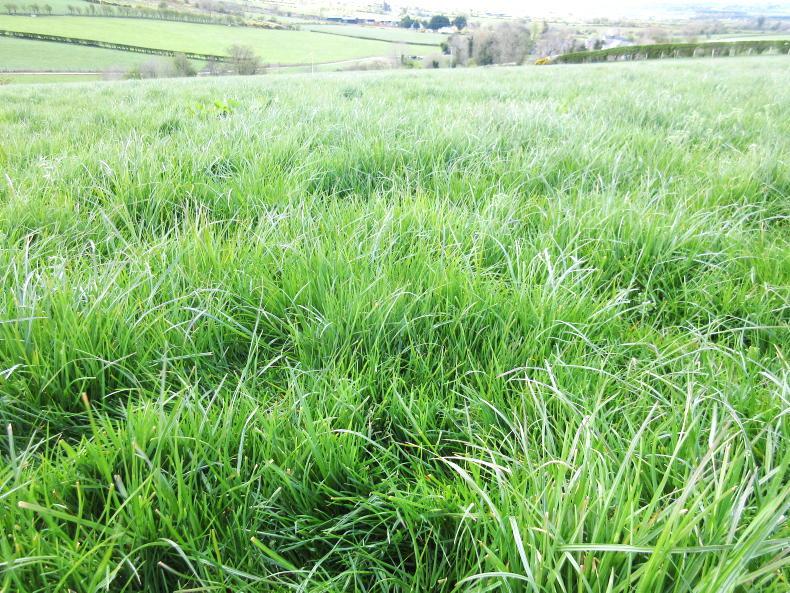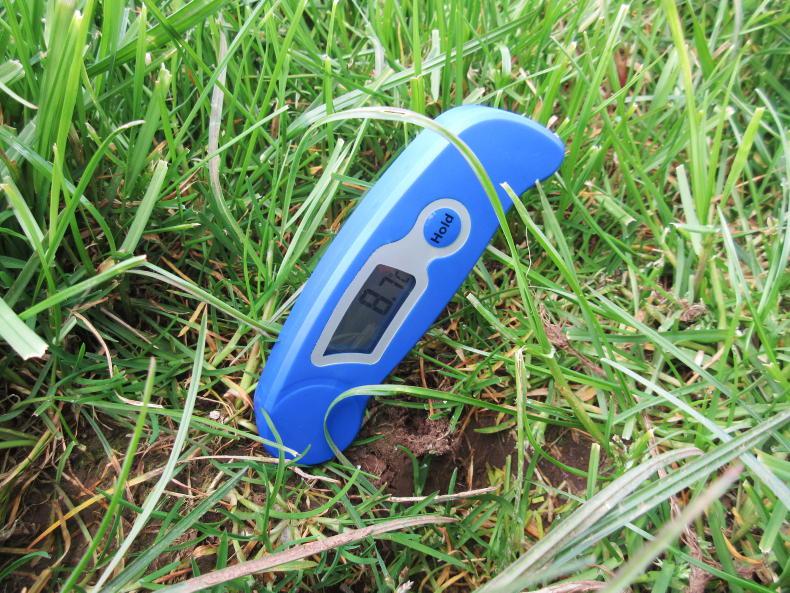Cold temperatures and dry conditions in recent weeks have posed challenges with managing grass.
In Limavady, Co Derry, John Oliver has recorded grass growth rates of 15kg to 20kg DM/ha/day over the last few weeks. It compares to rates of 50kg to 60kg DM/ha/day, which are more typical for this time of year.
John says low soil temperatures are the main reason for below-par growth rates on his farm.
He has a soil thermometer and he found that while temperatures were as high as 12°C in early April, the soil temperature recorded in the last two weeks has consistently been around 9°C.

John recorded growth rates of 15kg to 20kg DM/ha/day over the last few weeks.
No fertiliser has been applied on the Oliver farm since 12 April, but my advice during a visit last week was to apply around 35 units of nitrogen per acre on the grazing platform. This will ensure that nutrients are available for grass growth once temperatures start to rise again.
It means grass covers will build more rapidly than if John waits for warmer conditions before spreading fertiliser.
Wet weather and tight grass supplies meant John had to house cows for a few days over the past week. However, some grazing has been possible in paddocks where covers are approaching 3,000kg DM/ha (1,500kg DM/ha available cover).
Analysis of grass samples taken from these fields show the grass to be of high nutritive value, with a dry matter (DM) content of 20%, energy (ME) content of 12.3MJ/kg DM, while protein was 25%.

Soil temperatures remain below levels recorded in early April.
Feed was set at maintenance (M) plus 13 litres/cow/day, and I suggested leaving this unchanged for the time being.
However, when grass growth improves and cows are grazing full-time, it should be reviewed to get more milk from forage.
John also plans to offer the dairy herd 36-hour allocations of grass instead of more commonly used 12-hour or 24-hour breaks.
As John divides the grazing area up using an electric fence line, it is easy for him to allocate a larger area.
The benefits of this approach have been highlighted in recent AFBI research, which showed improved milk production with 36-hour paddocks over 12-hour paddocks and the effects were most pronounced among first-lactation heifers.
Breeding under way and monitoring youngstock
Breeding began within the dairy herd on 29 March and John Oliver (pictured) is satisfied with progress to date.
Over 90% of eligible cows were inseminated within the first three-week period. Heat detection has been carried out using a combination of tail painting and pedometer equipment.
Sires used include sexed AI straws of Possextown Faithful and Gabriel Zero, while other cows have been inseminated with Westcoast Praser.
The sires were selected as they have strong EBI and PLI indices, but they should also improve milk components (greater than 0.10% for butterfat and protein) and fertility within the herd in the longer term.
A beef bull is currently running with the herd and plans are in place to begin pregnancy diagnosis scanning in mid– to late May.
Oldest calves
Calves were turned out to grass on 23 April. The oldest calves are receiving around 2kg concentrate/calf/day, while calves born since February are still receiving milk replacer at 8l/calf/day plus concentrates.
John recently weighed the calves and found that average liveweight gain (LWG) within the group was 0.89kg. This exceeds the target LWG of 0.8kg and performance was uniform across the group.
Also, animals have shown no signs of ill thrift since turnout.
Calves received long-acting anthelmintic as part of the parasite control programme. My advice is to continue with the current supplementation regime and ensure that younger calves are consuming concentrate ahead of weaning.
In addition, it is important to keep weighing calves regularly to ensure that they continue to meet weight targets.
Silage and
reseeding plans
The plan is to harvest first-cut silage in mid-May, weather permitting. Silage ground has received around 2,500 to 3,000 gallons slurry/acre plus 2.7 bags/acre of 27% nitrogen fertiliser.
The silage area now includes two grazing paddocks with high residual covers over 2,000kg DM/ha.
These paddocks were grazed in the first rotation, but there was a poor cleanout, which John has put down to a high cover being carried over the winter. Cleaning the sward off for silage should lead to better grass utilisation over the rest of the grazing season.
John is also draining a six-acre piece of land on the farm and plans to reseed these fields using minimum cultivation techniques within the next week. Grass varieties selected for the fields include Gracehill, Callan and Fintona.
Grass growth rates remain below par on all Dairylink Ireland farms.Silage is being buffer-fed on some programme farms to reduce grazing demand.Weekly grass measuring, or at least regularly walking the grazing block, is critical at this time of year.
Cold temperatures and dry conditions in recent weeks have posed challenges with managing grass.
In Limavady, Co Derry, John Oliver has recorded grass growth rates of 15kg to 20kg DM/ha/day over the last few weeks. It compares to rates of 50kg to 60kg DM/ha/day, which are more typical for this time of year.
John says low soil temperatures are the main reason for below-par growth rates on his farm.
He has a soil thermometer and he found that while temperatures were as high as 12°C in early April, the soil temperature recorded in the last two weeks has consistently been around 9°C.

John recorded growth rates of 15kg to 20kg DM/ha/day over the last few weeks.
No fertiliser has been applied on the Oliver farm since 12 April, but my advice during a visit last week was to apply around 35 units of nitrogen per acre on the grazing platform. This will ensure that nutrients are available for grass growth once temperatures start to rise again.
It means grass covers will build more rapidly than if John waits for warmer conditions before spreading fertiliser.
Wet weather and tight grass supplies meant John had to house cows for a few days over the past week. However, some grazing has been possible in paddocks where covers are approaching 3,000kg DM/ha (1,500kg DM/ha available cover).
Analysis of grass samples taken from these fields show the grass to be of high nutritive value, with a dry matter (DM) content of 20%, energy (ME) content of 12.3MJ/kg DM, while protein was 25%.

Soil temperatures remain below levels recorded in early April.
Feed was set at maintenance (M) plus 13 litres/cow/day, and I suggested leaving this unchanged for the time being.
However, when grass growth improves and cows are grazing full-time, it should be reviewed to get more milk from forage.
John also plans to offer the dairy herd 36-hour allocations of grass instead of more commonly used 12-hour or 24-hour breaks.
As John divides the grazing area up using an electric fence line, it is easy for him to allocate a larger area.
The benefits of this approach have been highlighted in recent AFBI research, which showed improved milk production with 36-hour paddocks over 12-hour paddocks and the effects were most pronounced among first-lactation heifers.
Breeding under way and monitoring youngstock
Breeding began within the dairy herd on 29 March and John Oliver (pictured) is satisfied with progress to date.
Over 90% of eligible cows were inseminated within the first three-week period. Heat detection has been carried out using a combination of tail painting and pedometer equipment.
Sires used include sexed AI straws of Possextown Faithful and Gabriel Zero, while other cows have been inseminated with Westcoast Praser.
The sires were selected as they have strong EBI and PLI indices, but they should also improve milk components (greater than 0.10% for butterfat and protein) and fertility within the herd in the longer term.
A beef bull is currently running with the herd and plans are in place to begin pregnancy diagnosis scanning in mid– to late May.
Oldest calves
Calves were turned out to grass on 23 April. The oldest calves are receiving around 2kg concentrate/calf/day, while calves born since February are still receiving milk replacer at 8l/calf/day plus concentrates.
John recently weighed the calves and found that average liveweight gain (LWG) within the group was 0.89kg. This exceeds the target LWG of 0.8kg and performance was uniform across the group.
Also, animals have shown no signs of ill thrift since turnout.
Calves received long-acting anthelmintic as part of the parasite control programme. My advice is to continue with the current supplementation regime and ensure that younger calves are consuming concentrate ahead of weaning.
In addition, it is important to keep weighing calves regularly to ensure that they continue to meet weight targets.
Silage and
reseeding plans
The plan is to harvest first-cut silage in mid-May, weather permitting. Silage ground has received around 2,500 to 3,000 gallons slurry/acre plus 2.7 bags/acre of 27% nitrogen fertiliser.
The silage area now includes two grazing paddocks with high residual covers over 2,000kg DM/ha.
These paddocks were grazed in the first rotation, but there was a poor cleanout, which John has put down to a high cover being carried over the winter. Cleaning the sward off for silage should lead to better grass utilisation over the rest of the grazing season.
John is also draining a six-acre piece of land on the farm and plans to reseed these fields using minimum cultivation techniques within the next week. Grass varieties selected for the fields include Gracehill, Callan and Fintona.
Grass growth rates remain below par on all Dairylink Ireland farms.Silage is being buffer-fed on some programme farms to reduce grazing demand.Weekly grass measuring, or at least regularly walking the grazing block, is critical at this time of year. 







 This is a subscriber-only article
This is a subscriber-only article











SHARING OPTIONS: